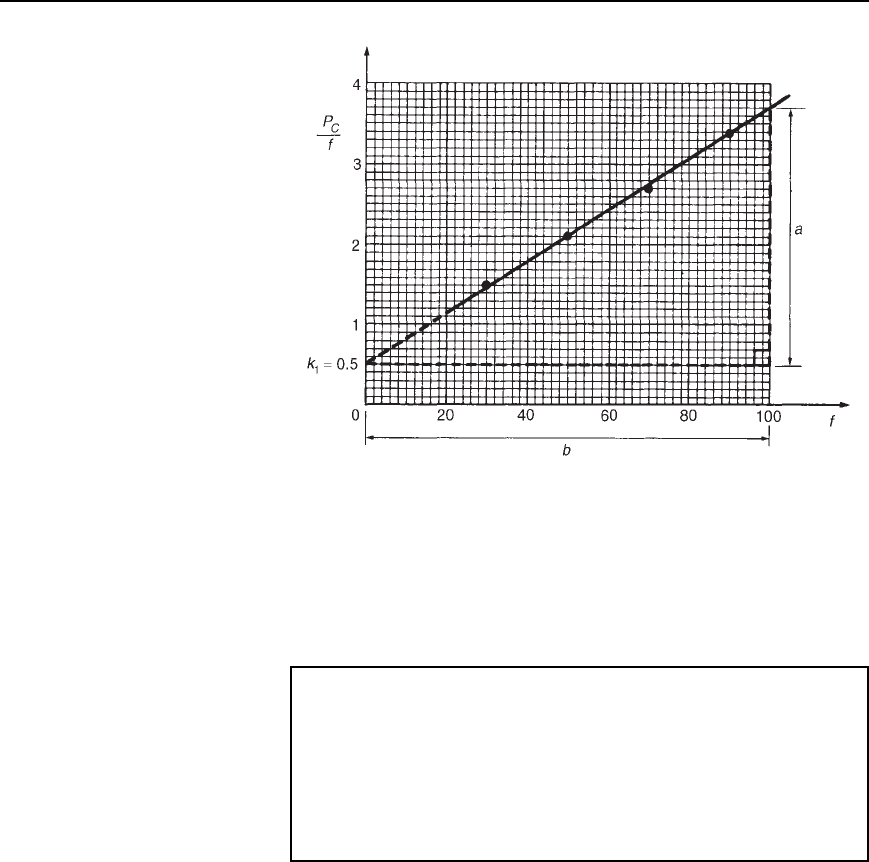Bird J. Electrical Circuit Theory and Technology
Подождите немного. Документ загружается.


698 Electrical Circuit Theory and Technology
From equation (38.4),
m
D B
m
2x. Hence induced e.m.f.
E D 4.44fNB
m
2x and, since the number of turns N D 1,
E D 8.88 B
m
fx volts 38.6
Resistance R is given by R D 0l/a, where 0 is the resistivity of the
lamination material. Since the current set up is confined to the two loop
sides (thus l D 2manda D υx ð 1m
2
), the total resistance of the path
is given by
R D
02
υx
D
20
υx
38.7
The eddy current loss in the two strips is given by
E
2
R
D
8.88
2
B
m
2
f
2
x
2
20/υx
from equations 38.6 and 38.7
D
8.88
2
B
m
2
f
2
x
2
υx
20
The total eddy current loss P
e
in the rectangular prism considered is given
by
P
e
D
t/2
0
8.88
2
B
m
2
f
2
20
x
2
dx D
8.88
2
B
m
2
f
2
20
x
3
3
t/2
0
D
8.88
2
B
m
2
f
2
20
t
3
24
watts
i.e.,
P
e
= k
e
.B
m
/
2
f
2
t
3
watts
38.8
where k
e
is a constant.
The volume of the prism is t ð 1 ð1 m
3
. Hence the eddy current loss
per m
3
is given by
P
e
= k
e
.B
m
/
2
f
2
t
2
watts per m
3
38.9
From equation (38.9) it is seen that eddy current loss is proportional to the
square of the thickness of the core strip. It is therefore desirable to make
lamination strips as thin as possible. However, at high frequencies where
it is not practicable to make very thin laminations, core losses may be
reduced by using ferrite cores or dust cores. Ferrite is a ceramic material
having magnetic properties similar to silicon steel, and dust cores consist
of fine particles of carbonyl iron or permalloy (i.e. nickel and iron), each
particle of which is insulated from its neighbour by a binding material.
Such materials have a very high value of resistivity.

Magnetic materials 699
Problem 5. The eddy current loss in a particular magnetic circuit
is 10 W/m
3
. If the frequency of operation is reduced from 50 Hz
to 30 Hz with the flux density remaining unchanged, determine the
new value of eddy current loss per cubic metre.
From equation (38.9), eddy current loss per cubic metre,
P
e
D k
e
B
m
2
f
2
t
2
or P
e
D kf
2
, where k D k
e
B
m
2
t
2
, since B
m
and t
are constant.
When the eddy current loss is 10 W/m
3
, frequency f is 50 Hz. Hence
10 D k50
2
, from which
constant k D
10
50
2
When the frequency is 30 Hz, eddy current loss,
P
e
D k30
2
D
10
50
2
30
2
D 3.6W=m
3
Problem 6. The core of a transformer operating at 50 Hz has an
eddy current loss of 100 W/m
3
and the core laminations have a
thickness of 0.50 mm. The core is redesigned so as to operate
with the same eddy current loss but at a different voltage and
at a frequency of 250 Hz. Assuming that at the new voltage the
maximum flux density is one-third of its original value and the
resistivity of the core remains unaltered, determine the necessary
new thickness of the laminations.
From equation (38.9), P
e
D k
e
B
m
2
f
2
t
2
watts per m
3
.
Hence, at 50 Hz frequency, 100 D k
e
B
m
2
50
2
0.50 ð 10
3
2
, from
which
k
e
D
100
B
m
2
50
2
0.50 ð 10
3
2
At 250 Hz frequency, 100 D k
e
B
m
3
2
250
2
t
2
i.e., 100 D
100
B
m
2
50
2
0.50 ð 10
3
2
B
m
3
2
250
2
t
2
D
100250
2
t
2
3
2
50
2
0.50 ð 10
3
2
from which t
2
D
1003
2
50
2
0.50 ð 10
3
2
100250
2
i.e., lamination thickness, t D
3500.50 ð 10
3
250
D 0.3 ð 10
3
m
or 0.30 mm

700 Electrical Circuit Theory and Technology
Problem 7. The core of an inductor has a hysteresis loss of
40 W and an eddy current loss of 20 W when operating at 50 Hz
frequency. (a) Determine the values of the losses if the frequency
is increased to 60 Hz. (b) What will be the total core loss if the
frequency is 50 Hz and the lamination are made one-half of their
original thickness? Assume that the flux density remains unchanged
in each case
(a) From equation (38.3). hysteresis loss, P
h
D k
h
vfB
m
n
D k
1
f
(where k
1
D k
h
vB
m
n
), since the flux density and volume are
constant. Thus when the hysteresis is 40 W and the frequency 50 Hz,
40 D k
1
50
from which, k
1
D
40
50
D 0.8
If the frequency is increased to 60 Hz,
hysteresis loss, P
h
D k
1
60 D 0.860 D 48 W
From equation (38.8),
eddy current loss, P
e
D k
e
B
m
2
f
2
t
3
D k
2
f
2
where k
2
D k
e
B
m
2
t
3
,
since the flux density and lamination thickness are constant.
When the eddy current loss is 20 W the frequency is 50 Hz. Thus
20 D k
2
50
2
from which k
2
D
20
50
2
D 0.008
If the frequency is increased to 60 Hz,
eddy current loss, P
e
D k
2
60
2
D 0.00860
2
D 28.8W
(b) The hysteresis loss, P
h
D k
h
vfB
m
n
, is independent of the thickness
of the laminations. Thus, if the thickness of the laminations is halved,
the hysteresis loss remains at 40 W
Eddy current loss P
e
D k
e
B
m
2
f
2
t
3
,i.e.P
e
D k
3
f
2
t
3
, where
k
3
D k
e
B
m
2
.
Thus 20 D k
3
50
2
t
3
from which k
3
D
20
50
2
t
3
When the thickness is t/2,P
e
D k
3
50
2
t/2
3
D
20
50
2
t
3
50
2
t/2
3
D 2.5W

Magnetic materials 701
Hence the total core loss when the thickness of the laminations is
halved is given by hysteresis loss C eddy current loss D 40 C2.5 D
42.5W
Problem 8. When a transformer is connected to a 500 V, 50 Hz
supply, the hysteresis and eddy current losses are 400 W and 150 W
respectively. The applied voltage is increased to 1 kV and the
frequency to 100 Hz. Assuming the Steinmetz index to be 1.6,
determine the new total core loss.
From equation (38.3), the hysteresis loss, P
h
D k
h
vfB
m
n
.From
equation (38.5), e.m.f., E D 4.44fNB
m
A, from which, B
m
˛E/f
since turns N and cross-sectional area, A are constants. Hence
P
h
D k
1
fE/f
1.6
D k
1
f
0.6
E
1.6
At 500 V and 50 Hz, 400 D k
1
50
0.6
500
1.6
,
from which, k
1
D
400
50
0.6
500
1.6
D 0.20095
At 1000 V and 100 Hz,
hysteresis loss, P
h
D k
1
100
0.6
1000
1.6
D 0.20095100
0.6
1000
1.6
D 800 W
From equation (38.8)
eddy current loss, P
e
D k
e
B
m
2
f
2
t
3
D k
2
E/f
2
f
2
D k
2
E
2
At 500 V, 150 D k
2
500
2
, from which
k
2
D
150
500
2
D 6 ð 10
4
At 1000 V,
eddy current loss, P
e
D k
2
1000
2
D 6 ð 10
4
1000
2
D 600 W
Hence the new total core loss D 800 C 600 D 1400 W
Further problems on eddy current loss may be found in Section 38.8, prob-
lems 7 to 12, page 708.
38.5 Separation of
hysteresis and eddy
current losses
From equation (38.3), hysteresis loss, P
h
D k
h
vfB
m
n
From equation (38.8), eddy current loss, P
e
D k
e
B
m
2
f
2
t
3
The total core loss P
c
is given by P
c
D P
h
C P
e
If for a particular inductor or transformer, the core flux density is
maintained constant, then P
h
D k
1
f, where constant k
1
D k
h
vB
m
n
,and

702 Electrical Circuit Theory and Technology
P
e
D k
2
f
2
, where constant k
2
D k
e
B
m
2
t
3
. Thus the total core loss
P
c
D k
1
f C k
2
f
2
and
P
c
f
= k
1
Y k
2
f
which is of the straight line form y D mx C c. Thus if P
c
/f is plotted
vertically against f horizontally, a straight line graph results having a
gradient k
2
and a vertical-axis intercept k
1
.
If the total core loss P
c
is measured over a range of frequencies, then
k
1
and k
2
may be determined from the graph of P
c
/f against f. Hence
the hysteresis loss P
h
D k
1
f and the eddy current loss P
e
D k
2
f
2
at a
given frequency may be determined.
The above method of separation of losses is an approximate one since
the Steinmetz index n is not a constant value but tends to increase with
increase of frequency. However, a reasonable indication of the relative
magnitudes of the hysteresis and eddy current losses in an iron core may
be determined.
Problem 9. The total core loss of a ferromagnetic cored trans-
former winding is measured at different frequencies and the results
obtained are:
Total core loss, P
c
(watts) 45 105 190 305
Frequency, f (hertz) 30 50 70 90
Determine the separate values of the hysteresis and eddy current
losses at frequencies of (a) 50 Hz and (b) 60 Hz.
To obtain a straight line graph, values of P
c
/f are plotted against f.
f(Hz) 30 50 70 90
P
c
/f 1.5 2.1 2.7 3.4
A graph of P
c
/f against f is shown in Figure 38.7. The graph is a straight
line of the form P
c
/f D k
1
C k
2
f
The vertical axis intercept at f D 0, k
1
= 0.5
The gradient of the graph, k
2
D
a
b
D
3.7 0.5
100
D 0.032
Since P
c
/f D k
1
C k
2
f, then P D k
1
f C k
2
f
2
, i.e.,
total core losses D hysteresis loss C eddy current loss.
(a) At a frequency of 50 Hz,
hysteresis loss D k
1
f D 0.550 D 25 W
eddy current loss D k
2
f
2
D 0.03250
2
D 80 W

Magnetic materials 703
Figure 38.7
(b) At a frequency of 60 Hz,
hysteresis loss D k
1
f D 0.560 D 30 W
eddy current loss D k
2
f
2
D 0.03260
2
D 115.2W
Problem 10. The core of a synchrogenerator has total losses of
400 W at 50 Hz and 498W at 60 Hz, the flux density being constant
for the two tests. (a) Determine the hysteresis and eddy current
losses at 50 Hz (b) If the flux density is increased by 25% and the
lamination thickness is increased by 40%, determine the hysteresis
and eddy current losses at 50 Hz. Assume the Steinmetz index to
be 1.7
(a) From equation (38.3),
hysteresis loss, P
h
D k
h
vfB
m
n
D k
1
f
(if volume
v and the maximum flux density are constant)
From equation (38.8),
eddy current loss, P
e
D k
e
B
m
2
f
2
t
3
D k
2
f
2
(if the maximum flux density and the lamination thickness are
constant)

704 Electrical Circuit Theory and Technology
Hence the total core loss P
c
D P
h
C P
e
i.e., P
c
D k
1
f C k
2
f
2
At 50 Hz frequency, 400 D k
1
50 C k
2
50
2
1
At 60 Hz frequency, 498 D k
1
60 C k
2
60
2
2
Solving equations (1) and (2) gives the values of k
1
and k
2
.
6 ð equation (1) gives: 2400 D 300k
1
C 15000k
2
3
5 ð equation (2) gives: 2490 D 300k
1
C 18000k
2
4
Equation (4)–equation (3) gives: 90 D 3000k
2
from which,
k
2
D 90/3000 D 0.03
Substituting k
2
D 0.03 in equation (1) gives 400 D 50k
1
C 75, from
which k
1
= 6.5 Thus, at 50 Hz frequency,
hysteresis loss P
h
D k
1
f D 6.550 D 325 W
eddy current loss P
e
D k
2
f
2
D 0.0350
2
D 75 W
(b) Hysteresis loss, P
h
D k
h
vfB
m
n
. Since at 50 Hz the flux density is
increased by 25%, the new hysteresis loss is (1.25)
1.7
times greater
than 325 W,
i.e., P
h
D 1.25
1.7
325 D 474.9W
Eddy current loss, P
e
D k
e
B
m
2
f
2
t
3
. Since at 50 Hz the flux density
is increased by 25%, and the lamination thickness is increased by
40%, the new eddy current loss is 1.25
2
1.4
3
times greater than
75 W,
i.e., P
e
D 1.25
2
1.4
3
75 D 321.6W
Further problems on the separation of hysteresis and eddy current losses
may be found in Section 38.8, problems 13 to 16, page 709.
38.6 Nonpermanent
magnetic materials
General
Nonpermanent magnetic materials are those in which magnetism may be
induced. With the magnetic circuits of electrical machines, transformers
and heavy current apparatus a high value of flux density B is desir-
able so as to limit the cross-sectional area A D BA and therefore the
weight and cost involved. At the same time the magnetic field strength
HD NI/l should be as small as possible so as to limit the I
2
R losses in
the exciting coils. The relative permeability
r
D B/
0
H) and the satu-
ration flux density should therefore be high. Also, when flux is continually
varying, as in transformers, inductors and armature cores, low hysteresis
and eddy current losses are essential.

Magnetic materials 705
Silicon-iron alloys
In the earliest electrical machines the magnetic circuit material used was
iron with low content of carbon and other impurities. However, it was later
discovered that the deliberate addition of silicon to the iron brought about
a great improvement in magnetic properties. The laminations now used in
electrical machines and in transformers at supply frequencies are made of
silicon-steel in which the silicon in different grades of the material varies
in amounts from about 0.5% to 4.5% by weight. The silicon added to iron
increases the resistivity. This in turn increases the resistance R D 0l/A
and thus helps to reduce eddy current loss. The hysteresis loss is also
reduced; however, the silicon reduces the saturation flux density.
A limit to the amount of silicon which may be added in practice is set
by the mechanical properties of the material, since the addition of silicon
causes a material to become brittle. Also the brittleness of a silicon-iron
alloy depends on temperature. About 4.5% silicon is found to be the
upper practical limit for silicon-iron sheets. Lohys is a typical example
of a silicon-iron alloy and is used for the armatures of d.c. machines and
for the rotors and stators of a.c. machines. Stalloy, which has a higher
proportion of silicon and lower losses, is used for transformer cores.
Silicon steel sheets are often produced by a hot-rolling process. In
these finished materials the constituent crystals are not arranged in any
particular manner with respect, for example, to the direction of rolling or
the plane of the sheet. If silicon steel is reduced in thickness by rolling in
the cold state and the material is then annealed it is possible to obtain a
finished sheet in which the crystals are nearly all approximately parallel to
one another. The material has strongly directional magnetic properties, the
rolling direction being the direction of highest permeability. This direction
is also the direction of lowest hysteresis loss. This type of material is
particularly suitable for use in transformers, since the axis of the core can
be made to correspond with the rolling direction of the sheet and thus
full use is made of the high permeability, low loss direction of the sheet.
With silicon-iron alloys a maximum magnetic flux density of about
2 T is possible. With cold-rolled silicon steel, used for large machine
construction, a maximum flux density of 2.5 T is possible, whereas the
maximum obtainable with the hot-rolling process is about 1.8 T. (In fact,
with any material, only under the most abnormal of conditions will the
value of flux density exceed 3 T.)
It should be noted that the term ‘iron-core’ implies that the core is
made of iron; it is, in fact, almost certainly made from steel, pure iron
being extremely hard to come by. Equally, an iron alloy is generally a
steel and so it is preferred to describe a core as being a steel rather than
an iron core.
Nickel-iron alloys
Nickel and iron are both ferromagnetic elements and when they are
alloyed together in different proportions a series of useful magnetic
alloys is obtained. With about 25%–30% nickel content added to iron,
the alloy tends to be very hard and almost nonmagnetic at room

706 Electrical Circuit Theory and Technology
temperature. However, when the nickel content is increased to, say,
75%–80% (together with small amounts of molybdenum and copper),
very high values of initial and maximum permeabilities and very low
values of hysteresis loss are obtainable if the alloys are given suitable
heat treatment. For example, Permalloy, having a content of 78% nickel,
3% molybdenum and the remainder iron, has an initial permeability of
20000 and a maximum permeability of 100000 compared with values
of 250 and 5000 respectively for iron. The maximum flux density for
Permalloy is about 0.8 T. Mumetal (76% nickel, 5% copper and 2%
chromium) has similar characteristics. Such materials are used for the
cores of current and a.f. transformers, for magnetic amplifiers and also
for magnetic screening. However, nickel-iron alloys are limited in that
they have a low saturation value when compared with iron. Thus, in
applications where it is necessary to work at a high flux density, nickel-
iron alloys are inferior to both iron and silicon-iron. Also nickel-iron
alloys tend to be more expensive than silicon-iron alloys.
Eddy current loss is proportional to the thickness of lamination squared,
thus such losses can be reduced by using laminations as thin as possible.
Nickel-iron alloy strip as thin as 0.004 mm, wound in a spiral, may
be used.
Dust cores
In many circuits high permeability may be unnecessary or it may be more
important to have a very high resistivity. Where this is so, metal powder or
dust cores are widely used up to frequencies of 150 MHz. These consist
of particles of nickel-iron-molybdenum for lower frequencies and iron
for the higher frequencies. The particles, which are individually covered
with an insulating film, are mixed with an insulating, resinous binder and
pressed into shape.
Ferrites
Magnetite, or ferrous ferrite, is a compound of ferric oxide and ferrous
oxide and possesses magnetic properties similar to those of iron. However,
being a semiconductor, it has a very high resistivity. Manufactured ferrites
are compounds of ferric oxide and an oxide of some other metal such as
manganese, nickel or zinc. Ferrites are free from eddy current losses at
all but the highest frequencies (i.e., >100 MHz) but have a much lower
initial permeability compared with nickel-iron alloys or silicon-iron alloys.
Ferrites have typically a maximum flux density of about 0.4 T. Ferrite
cores are used in audio-frequency transformers and inductors.
38.7 Permanent
magnetic materials
A permanent magnet is one in which the material used exhibits magnetism
without the need for excitation by a current-carrying coil. The silicon-iron
and nickel-iron alloys discussed in Section 38.6 are ‘soft’ magnetic mate-
rials having high permeability and hence low hysteresis loss. The opposite
characteristics are required in the ‘hard’ materials used to make permanent

Magnetic materials 707
magnets. In permanent magnets, high remanent flux density and high
coercive force, after magnetization to saturation, are desirable in order to
resist demagnetization. The hysteresis loop should embrace the maximum
possible area. Possibly the best criterion of the merit of a permanent
magnet is its maximum energy product BH
m
, i.e., the maximum value
of the product of the flux density B and the magnetic field strength H along
the demagnetization curve (shown as cd in Figure 38.2). A rough criterion
is the product of coercive force and remanent flux density, i.e. (Od)(Oc)
in Figure 38.2. The earliest materials used for permanent magnets were
tungsten and chromium steel, followed by a series of cobalt steels, to give
both a high remanent flux density and a high value of BH
m
Alni was the first of the aluminium-nickel-iron alloys to be discovered,
and with the addition of cobalt, titanium and niobium, the Alnico series
of magnets was developed, the properties of which vary according to
composition. These materials are very hard and brittle. Many alloys with
other compositions and trade names are commercially available.
A considerable advance was later made when it was found that
directional magnetic properties could be induced in alloys of suitable
composition if they were heated in a strong magnetic field. This discovery
led to the powerful Alcomex and Hycomex series of magnets. By using
special casting techniques to give a grain-oriented structure, even better
properties are obtained if the field applied during heat treatment is parallel
to the columnar crystals in the magnet. The values of coercivity, the
remanent flux density and hence BH
m
are high for these alloys.
The most recent and most powerful permanent magnets discovered are
made by powder metallurgy techniques and are based on an intermetallic
compound of cobalt and samarium. These are very expensive and are only
available in a limited range of small sizes.
38.8 Further problems
on magnetic materials
Hysteresis loss
1 The area of a hysteresis loop obtained from a specimen of steel is
2000 mm
2
. The scales used are: horizontal axis 1 cm D 400 A/m;
vertical axis 1 cm D 0.5 T. Determine (a) the hysteresis loss per m
3
per cycle, (b) the hysteresis loss per m
3
at a frequency of 60 Hz. (c) If
the maximum flux density is 1.2 T at a frequency of 60 Hz, determine
the hysteresis loss per m
3
for a maximum flux density of 1 T and a
frequency of 20 Hz, assuming the Steinmetz index to be 1.7.
[(a) 4 kJ/m
3
(b) 240 kW/m
3
(c) 58.68 kW/m
3
]
2 A steel ring has a uniform cross-sectional area of 1500 mm
2
and a
mean circumference of 800 mm. A hysteresis loop obtained for the
specimen is plotted to scales of 1 cm D 0.05 T and 1 cm D 100 A/m
and it is found to have an area of 720 cm
2
. Determine the hysteresis
loss at a frequency of 50 Hz. [216 W]
3 What is hysteresis? Explain how a hysteresis loop is produced for
a ferromagnetic specimen and how its area is representative of the
hysteresis loss.
